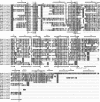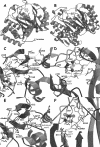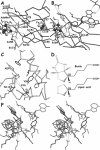AdoMet radical proteins--from structure to evolution--alignment of divergent protein sequences reveals strong secondary structure element conservation
- PMID: 15289575
- PMCID: PMC506812
- DOI: 10.1093/nar/gkh728
AdoMet radical proteins--from structure to evolution--alignment of divergent protein sequences reveals strong secondary structure element conservation
Abstract
Eighteen subclasses of S-adenosyl-l-methionine (AdoMet) radical proteins have been aligned in the first bioinformatics study of the AdoMet radical superfamily to utilize crystallographic information. The recently resolved X-ray structure of biotin synthase (BioB) was used to guide the multiple sequence alignment, and the recently resolved X-ray structure of coproporphyrinogen III oxidase (HemN) was used as the control. Despite the low 9% sequence identity between BioB and HemN, the multiple sequence alignment correctly predicted all but one of the core helices in HemN, and correctly predicted the residues in the enzyme active site. This alignment further suggests that the AdoMet radical proteins may have evolved from half-barrel structures (alphabeta)4 to three-quarter-barrel structures (alphabeta)6 to full-barrel structures (alphabeta)8. It predicts that anaerobic ribonucleotide reductase (RNR) activase, an ancient enzyme that, it has been suggested, serves as a link between the RNA and DNA worlds, will have a half-barrel structure, whereas the three-quarter barrel, exemplified by HemN, will be the most common architecture for AdoMet radical enzymes, and fewer members of the superfamily will join BioB in using a complete (alphabeta)8 TIM-barrel fold to perform radical chemistry. These differences in barrel architecture also explain how AdoMet radical enzymes can act on substrates that range in size from 10 atoms to 608 residue proteins.
Figures





Similar articles
-
Structure of an archaeal TYW1, the enzyme catalyzing the second step of wye-base biosynthesis.Acta Crystallogr D Biol Crystallogr. 2007 Oct;63(Pt 10):1059-68. doi: 10.1107/S0907444907040668. Epub 2007 Sep 19. Acta Crystallogr D Biol Crystallogr. 2007. PMID: 17881823
-
Ribonucleotide reductases: divergent evolution of an ancient enzyme.J Mol Evol. 2002 Aug;55(2):138-52. doi: 10.1007/s00239-002-2311-7. J Mol Evol. 2002. PMID: 12107591
-
Radical S-adenosylmethionine enzyme coproporphyrinogen III oxidase HemN: functional features of the [4Fe-4S] cluster and the two bound S-adenosyl-L-methionines.J Biol Chem. 2005 Aug 12;280(32):29038-46. doi: 10.1074/jbc.M501275200. Epub 2005 Jun 20. J Biol Chem. 2005. PMID: 15967800
-
S-adenosylmethionine radical enzymes.Bioorg Chem. 2004 Oct;32(5):326-40. doi: 10.1016/j.bioorg.2004.06.001. Bioorg Chem. 2004. PMID: 15381399 Review.
-
Structure and function of radical SAM enzymes.Curr Opin Chem Biol. 2004 Oct;8(5):468-76. doi: 10.1016/j.cbpa.2004.08.001. Curr Opin Chem Biol. 2004. PMID: 15450488 Review.
Cited by
-
Defining Caenorhabditis elegans as a model system to investigate lipoic acid metabolism.J Biol Chem. 2020 Oct 30;295(44):14973-14986. doi: 10.1074/jbc.RA120.013760. Epub 2020 Aug 25. J Biol Chem. 2020. PMID: 32843480 Free PMC article.
-
Assembly of Lipoic Acid on Its Cognate Enzymes: an Extraordinary and Essential Biosynthetic Pathway.Microbiol Mol Biol Rev. 2016 Apr 13;80(2):429-50. doi: 10.1128/MMBR.00073-15. Print 2016 Jun. Microbiol Mol Biol Rev. 2016. PMID: 27074917 Free PMC article. Review.
-
Radical S-adenosylmethionine enzymes.Chem Rev. 2014 Apr 23;114(8):4229-317. doi: 10.1021/cr4004709. Epub 2014 Jan 29. Chem Rev. 2014. PMID: 24476342 Free PMC article. Review. No abstract available.
-
Chlamydia trachomatis serovar L2 can utilize exogenous lipoic acid through the action of the lipoic acid ligase LplA1.J Bacteriol. 2010 Dec;192(23):6172-81. doi: 10.1128/JB.00717-10. Epub 2010 Sep 24. J Bacteriol. 2010. PMID: 20870766 Free PMC article.
-
Structural basis for methyl transfer by a radical SAM enzyme.Science. 2011 May 27;332(6033):1089-92. doi: 10.1126/science.1205358. Epub 2011 Apr 28. Science. 2011. PMID: 21527678 Free PMC article.
References
-
- Sofia H.J., Chen,G., Hetzler,B.G., Reyes-Spindola,J.F. and Miller,N.E. (2001) Radical SAM, a novel protein superfamily linking unresolved steps in familiar biosynthetic pathways with radical mechanisms: functional characterization using new analysis and information visualization methods. Nucleic Acids Res., 29, 1097–1106. - PMC - PubMed
-
- Frey P.A. and Booker,S.J. (2001) Radical mechanisms of S-adenosylmethionine-dependent enzymes. Adv. Protein Chem., 58, 1–45. - PubMed
-
- Hewitson K.S., Baldwin,J.E., Shaw,N.M. and Roach,P.L. (2000) Mutagenesis of the proposed iron–sulfur cluster binding ligands in Escherichia coli biotin synthase. FEBS Lett., 466, 372–376. - PubMed
-
- Hewitson K.S., Ollagnier-de Choudens,S., Sanakis,Y., Shaw,N.M., Baldwin,J.E., Munck,E., Roach,P.L. and Fontecave,M. (2002) The iron–sulfur center of biotin synthase: site-directed mutants. J. Biol. Inorg. Chem., 7, 83–93. - PubMed
-
- Layer G., Verfurth,K., Mahlitz,E. and Jahn,D. (2002) Oxygen-independent coproporphyrinogen-III oxidase HemN from Escherichia coli. J. Biol. Chem., 277, 34136–34142. - PubMed
Publication types
MeSH terms
Substances
LinkOut - more resources
Full Text Sources
Molecular Biology Databases

